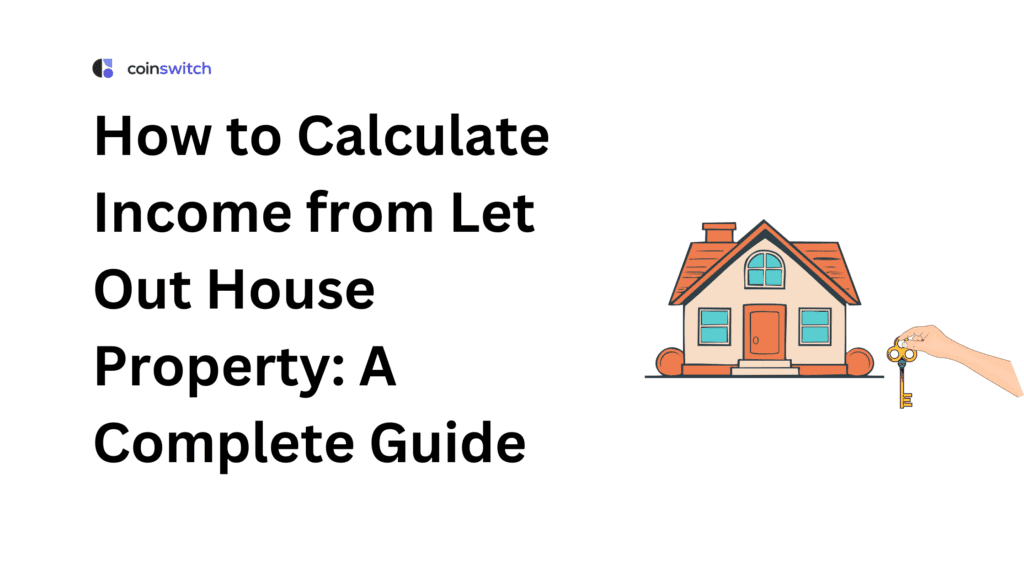Renting out a house or a business generates rental income. You need to report this income in your income tax return under the section for Income from House Property. You may include this income in your net income. The issue, however, is how much tax you must pay on this rental income.
The calculation is based on a formula outlined in the Income Tax Act, which may appear intricate at first. But there’s no need to stress. This blog post will help you understand the steps to figure out your income from your let-out property.
What is Let Out House Property?
Letting out means giving a residential property, a commercial space, or vacant land to someone else for a set amount of time in exchange for rent. At any time during the year, you can rent it out and earn income from the rent. A property is considered to be let-out if it is rented out partially or fully throughout the year. Let-out may also apply to properties that are not self-occupied.
Understanding Key Components of the Calculation
It’s crucial to comprehend the primary components involved in calculating revenue from a let-out property before you begin the computation. These components ensure that you maximize available deductions and serve as the foundation for accurate tax reporting. The following is a rundown of the information that you need to be aware of:
Municipal Taxes
Local municipal authorities collect property taxes, known as municipal taxes. To determine the property’s Net Annual Value (NAV), these taxes may be subtracted from the Gross Annual Value (GAV). The property owner must pay the tax to use this exemption.
The owner of a let-out property is not eligible to get this benefit if the tenant has already paid the tax. It’s also not necessary for the local taxes to only cover that fiscal year. You can deduct paid municipal taxes under both the old and current tax regimes.
Standard Deduction
You may take a regular reduction of 30% of the Net Annual Value (NAV). This benefit is meant to cover maintenance and repairs as well as other expenses associated with the property. You may take this deduction even if you haven’t incurred these expenses. Both the old and new tax systems let you take standard deductions.
Interest on Home Loan
Interest paid on a loan used to buy, build, or remodel a residential property may be deducted from your taxes. You can deduct the actual amount of interest paid throughout the fiscal year. Under both the old and new tax regimes, you may take advantage of this interest deduction if your property is rented out. However, in the new tax regime, the deduction is allowed to the extent of rent, and excess interest cannot be set off against other income heads. In the old regime, excess interest gets reduced from other heads.
Principal Repayment
Earlier, taxpayers were allowed to deduct up to ₹1.5 lakh annually from the principal repayment of house loans under Section 80C of the old tax system. However, this benefit is not available in the new tax regime.
Loss Set-off
You could set off losses from home property against other types of income, including salaries and business earnings, under the previous tax system. The amount of the set-off is limited to ₹2 lakh per year. However, under the current tax system, losses from let-out property cannot be set off from other sources of income.
Carry-Forward
You were able to carry over excess losses (those that were more than ₹2 lakh) for a period of up to eight years under the old tax structure. You can only deduct income from residential property earned in the following years to offset the loss you sustained. Carrying forward losses is not an option under the new tax system, which means that losses cannot be carried forward.
Step-by-Step Guide to Calculating Income from Let-Out Property
The method of calculating income from a let-out property may seem difficult at first, but it becomes simple if each element is understood correctly. It’s crucial to approach the calculation carefully, whether you’re an individual assessing your tax obligations or a first-time landlord.
Here are some easy steps that will help you understand how to do it:
- Step 1: Calculate the Gross Annual Value (GAV): This exceeds both the actual rent you received and a reasonable rental estimate for the entire year.
- Step 2: Deduct Municipal Taxes Paid: To get the Net Annual Value (NAV), deduct the local taxes due from the GAV.
- Step 3: Apply Standard Deduction: Calculate an allowance for property maintenance by deducting thirty percent of the net asset value (NAV).
- Step 4: Deduct Interest on Home Loan: Deduct the total amount of interest that you paid on your loan during that particular fiscal year.
- Step 5: Include Principal Repayment (Old Regime Only): Adhere to the previous regulations and include a deduction for the principal of the loan.
- Step 6: Assess Loss Set‑off / Carry‑forward (Old Regime Only): You can deduct losses from other income each year up to a certain level, and you can carry forward any excess for up to eight years.
Read More: Types of Deeds: Five Ways of Transferring or Acquiring Real Estate Property
Case Scenario for Calculation of Income (As per Old Tax Regime)
It is crucial to understand the calculation procedure under the previous tax system when determining the taxable income from a let-out property. Property owners can significantly reduce their taxable income by utilizing deductions offered by this strategy.
Let’s examine a case study for the 2024–2025 fiscal year, fully demonstrating each stage.
Property Details for FY 2024–25
You own a residential home in a city, and you rent it out all year. The owner has paid municipal taxes throughout the year, and the property consistently generates a monthly rental income. The property has an ongoing home loan, and the interest was paid off in the same fiscal year.
Step 1: Calculate the Gross Annual Value (GAV)
First, the Gross Annual Value (GAV) has to be determined. GAV is the total rent received in a year.
Step 2: Subtract Municipal Taxes Paid
Deduct municipal taxes paid to the local authority during the fiscal year from GAV to get the Net Annual Value (NAV).
Step 3: Apply Standard Deduction (30% of NAV)
After calculating the NAV, a standard deduction of 30% is applied to the NAV. Regardless of the owner’s actual expenses, this deduction covers property maintenance, repairs, and general upkeep. This step ensures fair tax treatment for outflows related to maintenance while streamlining the process.
Step 4: Deduct Interest on the Home Loan
The owner of a let-out property can claim a deduction on home loan interest under Section 24 (b) of the Income Tax Act. There is no cap on the interest deduction for let-out property under the old tax regime.
By meticulously following these steps, owners of let-out properties can precisely determine their income and fully utilize the deductions available under the previous tax system.
Read More: Understanding Promissory Note and Loan Agreement
Conclusion
You can quickly determine your taxable income by knowing the fundamentals of calculating revenue from a let-out property. Utilize all of the available deductions to lower your tax obligation. Therefore, for hassle-free tax compliance, ensure you maintain thorough records of all your payments and deductions. You may get assistance from a knowledgeable financial advisor in accurately calculating the revenue from the let-out property.
FAQs
1. How will you compute income from let-out house property?
Calculate the gross annual value (total rent received in a year), deduct municipal taxes, claim a standard deduction of 30%, and subtract interest on your house loan. Under the old tax regime, you can also include principal repayment and loss set‑off.
2. How do you determine the annual value of the let-out property?
When a property is let out, the gross annual value is the rental value of the property. The annual value of a let-out property is determined by assessing the potential rental income it could generate in a year.
3. How is the rental income calculated?
To figure out rental income, you first calculate the Gross Annual Value (total rent received in a year), and then deduct municipal taxes to obtain the Net Annual Value. Next, apply a standard deduction of 30% and subtract the interest paid on a home loan to determine the taxable income.
4. How do you show income from house rent?
If you make money from renting out your property, you should record it under the Income from House Property part of your tax return. After deducting things like standard deductions, home loan interest, and municipal taxes, figure out the taxable amount and declare it appropriately.








